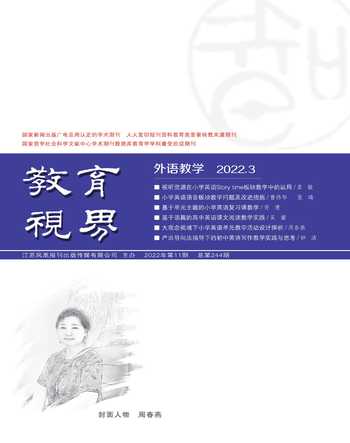产出导向法指导下的初中英语写作教学实践与思考

*本文系南京市教学研究第十三期课题 “群文阅读影响下的初中英语模块教学的实践研究”(课题编号:2019NJJK13-L33)的阶段性研究成果。
【设计理念】
产出导向法提倡学用一体,利用输出驱动、输入促成、选择学习和以评为学四个教学假设,创设以教师主动和师生共建为前提的教学流程。译林版英语教材中每个单元以输出任务为驱动,经过单元内容、语言和话语结构的输入促成,最终通过Task板块达成写作输出。在Task板块教学中,教师可以利用产出导向法的“驱动—促成—评价”循环链设计教学,通过加强输入性语言学习和产出性语言运用之间的联系,克服写作课中常见的学用分离问题,提高学生的写作能力,进而提升学生语言能力、思维品质等学科核心素养。
【教学内容分析】
本节课的教学内容是译林版初中英语八年级上册Unit 5 Wild animals的Task板块,主要任务是用英文完成一篇关于濒危动物的报告。本单元属于本册教材的第二大模块,该模块主题为“Nature and the environment”,旨在通过带领学生了解野生动物的习性与生存现状,培养其保护野生动物、关心生态环境的意识。
本课以Task板块中Simon撰写的一篇关于熊的报告为示范案例,通过“Simon的写前构思笔记”“依据写前构思笔记完成的报告”和“同伴讨论,自由创作”三部分内容帮助学生达成写作目标。
【教学目标】
经过本节课的学习,学生能够:
1. 利用写前构思笔记整理思路,完成一篇关于濒危动物的报告。
2. 理解构思要点的内部拓展以及要点之间的关联,并用合适的语言形式进行报告类文体写作。
3. 在了解濒危动物的基础上,思考保护野生动物与生态环境对人类社会生活的影响,进而增强环保责任意识。
【教学过程】
一、呈现任务,输出驱动
驱动是产出导向法的首要环节,包括呈现交际场景、提出产出任务和学生尝试产出,其目的是激发学生的产出欲望,调动学生的学习积极性。
上课伊始,教师呈现一些濒危动物的图片,引导学生讨论其现状。随后,教师呈现写作任务,利用输出任务激发学生产出的欲望。师生对话如下:
师:There are many wild animals in danger. (出示濒危动物图片)Do you know them?
(学生讨论濒危动物现状)
师:Wild Animals Club newsletter calls for reports on animals in danger. This will let more people know the animals situations and help save them. Can you write such a report to help? Do you know how to finish a report on animals in danger?
生:We need to introduce the animal, about its name, looks and living environment.
生:We can use some pictures to make the report vivid, but I think a report is difficult to write.
[设计意图:单元初始板块已经提出了产出驱动任务,但是距离本节课时间已久且交际场景不够明确。因此,教师通过提问和复现濒危动物的图片,呈现本节课的交际场景,明确写作任务,激发学生进行产出的积极性和主动性。]
二、分层指导,促成产出
促成环节是产出导向法的核心。教师需要引导学生选择性学习书面语篇、视频等输入性材料,从中选择产出任务所需的文章结构、语言和观点。
(一)结构促成
为帮助学生学会使用笔记构思文章结构,教师呈现Simon为写好一份濒危动物报告而准备的构思笔记,引导学生掌握报告类文体常见的语篇结构。接着,教师引导学生评价笔记内容,分析报告中除了looks、food、abilities、qualities、danger,还能增加哪些要点。师生对话如下:
师:What do you find in Simons notes? How many parts are there?
生:There are 5 parts. They are looks, food, abilities, qualities and danger.
师:Whats the function of these points?
生:They can help Simon write a report.
师:Yes, maybe. Can you organize one paragraph about the first point — looks?
生:Bears are big and heavy. They have large bodies, short and strong legs. They also have large paws and short tails.
师:Excellent! You use the details to describe one point of the bears. Can you guess how many paragraphs are there in Simons report?
生:Five.
师:You are right. Each point can become an independent paragraph. What do you think of Simons notes? Are they perfect? If not, can we make them better?
生:I think we can add one more point, protection, and talk about what we can do to protect bears.
师:You can put this wonderful point into your own report.
[设计意图:结构促成聚焦文章的逻辑结构和语篇意识。结构促成的训练能够帮助学生提升谋篇布局的能力。通过学习构思笔记的功能、组成部分等,学生能够掌握构思笔记对于文章结构的规划作用。在此基础之上,教师倡导学生评价笔记内容,以评为学,培养学生独立思考能力和批判性思维。]
(二)语言促成
教师引导学生根据构思笔记的内容,完成Simon的报告。接着,教师引导学生在语篇情境中理解和识记报告中的新单词。最后,教师引导学生分析和评价报告中语言表达的逻辑性、连贯性、丰富性及说服力。师生对话如下:
师:Please help Simon finish his report with the information in the notes. There may be some new words. Have a guess of their meanings in the context.
(呈现单词paw、tail、insect及相应图片)
师:Its good to learn some new words about the bears. Now, please read Simons report carefully again, and find out the meaningful words and phrases that you like best. Lets begin with the first paragraph.
(学生细读报告第一段)
生:I think the words are simple, but the writer talks about the bear in whole and then in details.
师:You mean the logic order — from general to specific?
生:Yes.
师:Actually this order makes a report very logical, which is very necessary when you are writing a report.
师:How about the second paragraph? Any word or phrase that you think is perfect?
(学生细读报告第二段)
生:I think “but” is good. It tells us there are different kinds of bears and they like different things.
师:Yes. “But” is a very typical conjunction. It can compare or contrast two things and also make the writing cohesive. We should try to use some conjunctions in our writing.
师:Anything special in Paragraphs 3 and 4?
(学生细读报告第三与第四段)
生:Simon uses “can do” “be good at” to talk about bears abilities.
师:Thats right. We can use different expressions to make our sentences more colourful. Any other expressions can you think of?
生:Be able to. Bears are able to run very fast.
师:In our daily learning, we can collect the synonyms so we will have more choices in writing. Many of you like the last paragraph best. Which word do you prefer?
(学生细读报告最后一段)
生:Sadly, should, otherwise, there may be no left ...
师:What can you feel from these words?
生:The writers strong feelings and opinions.
师:Thats right. We can easily feel the writers emotions about the wild animals in danger. That makes the report more persuasive.
[设计意图:语言促成的重点是引导学生关注具体的语言表达。词、句的使用分析不能与文本割裂。教师通过提问、对比、评价等方式,引导学生在语篇情境中学习新单词的意义及用法,赏析不同的语言表达,体会保护野生动物话题的报告类文体的语言特点。]
(三)观点促成
写作不仅要求语言准确,注重行文内在逻辑,还要体现思维含量,关注学生思维品质的培养。
教师通过之前铺垫的新增观点protection,鼓励学生结合文本内容,整合本单元观点,提出保护濒危动物的具体行为人和相应做法。随后,教师根据报告内容和动物爱护者为金丝猴发声的一段留言,引导学生思考人类和自然的关系。师生对话如下:
师:Still in the last paragraph, the writer mentions that we should take action to stop this. Maybe we can think further and deeper in this direction. So, who will take action? What actions will they take?
生:The government can make more laws to protect bears.
生:Buyers should refuse to buy things from their fur or bodies.
生:We students can write more reports to tell others about the situation of bears.
师:Wonderful. Maybe you can think more and write them in your reports. Looking at the last sentence of the report, have you ever imagined the world without bears or other wild animals? What will the world without wild animals be like?
生:Humans will feel very lonely.
生:The world will not be colourful as now.
师:Thats right. Maybe we should hear more voices(出示为金丝猴发声的动物爱护者留言).
师:What other thoughts do you get from the animal lovers words?
生:More animals are in danger too because of humans behaviours.
生:Humans will hurt themselves if they continue to kill or eat animals.
师:I like your ideas! Can you further explain them?
生:We should protect wild animals not only because they are in danger or may disappear, but also because protecting them is also protecting humans as well. We, the animals, the environment, are as a whole.
[设计意图:观点促成关注学生思维品质的培养。教师引导学生分析和揣摩文字和图片中传递的信息、观点、情感和态度,一方面培养学生“看”的技能,另一方面促进其发散思维,提出自己的观点。]
三、以评促学,产出评价
评价旨在了解学生的任务完成情况,检验学生的学习成果,就疑难点和普遍出现的问题进行补救性教学,同时也为下一步教学方案的制订和调整提供参考。
以动物爱护者的留言为铺垫,教师播放《我们诞生在中国》纪录片中金丝猴淘淘的一段英文视频,鼓励学生搜集、记录并整理信息,依据笔记和本课所学知识,完成一篇关于金丝猴的报告。
在产出任务展示阶段,教师首先组织学生运用英语写作能力综合评价表(见表1),完成自评。接着,学生在小组内部交换作品,开展组内评价。每个小组选出一名代表,展示评价表,指出一篇习作的优缺点,并给出改进建议。教师根据学生的发言,就一些常见错误进行补救性教学,引导学生根据建议自主修改作文。最后,教师以一篇学生作品为例,从内容、语言和结构层面进行师生共评。
[ 设计意图:《普通高中英语课程标准(2017年版2020年修订)》提出,要突出学生在评价中的主体地位,提倡学生开展自评和互评,加强学生之间、师生之间评价信息的互动交流。运用综合评价表进行自评与互评,既能检测学生写作任务的达成程度,又能促进学生互相交流学习,在同伴学习中取长补短,提升写作能力。]
【教学反思】
一、精选材料,提升促成效果
写作课实施产出导向法具有一定难度,其中促成环节的效率至关重要。时长控制不好,会缩短学生自主写作时间,影响写作产出;促成环节质量也将影响学生产出任务的质量。因此,教师要以教材文本为基础,选取合适、精准的输入性材料。例如,本课构思笔记能够帮助学生掌握写作结构,连词、同义词组的表达有助于学生理解语言形式等。同时,除了教材文本,教师也要拓展延续性的输入材料。例如,为金丝猴发声的动物爱护者的留言以及相关纪录片为学生自主产出搭设了情境与素材的脚手架。
二、以评促学,关注学用一体
产出导向法提倡以评促学,主张在教师专业引领下,学生边评边学,边学边评,打破“学”与“评”的界限,将评价作为学习的强化、深入阶段。以评促学,不应只停留在最后的评价阶段,而应贯穿整节课。例如,在结构促成环节,教师有意识地引导学生评价Simon的构思笔记;在语言促成环节,教师以学生点评报告语言为主要形式,开展语言赏析活动。学生在评价中学习、分析与欣赏,思维品质与写作综合能力不断提升。产出导向法倡导学用一体,输入性学习和产出性运用紧密结合,两者有机联动。本节课促成阶段的学习促使学生边学边评,为写作产出服务,体现了学中用、用中学、学用结合的思想。
(钟洁,江苏省南京市第一中学初中部,邮编:210002)

